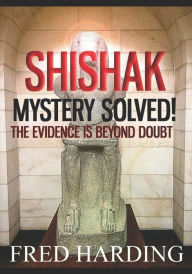Shishak Mystery Solved!: The Evidence is Beyond Doubt Fred Harding Author
Shishak Mystery Solved!: The Evidence is Beyond Doubt Fred Harding Author
In the fifth year of King Rehoboam, King Shishak of Egypt marched against Jerusalem. (1 Kings 14:25) Nearly all Egyptologists identify Shishak with Shoshenq I of the 22nd dynasty (943 BC -716 BC) and this is still the majority position. However, ...
Read more
In the fifth year of King Rehoboam, King Shishak of Egypt marched against Jerusalem. (1 Kings 14:25) Nearly all Egyptologists identify Shishak with Shoshenq I of the 22nd dynasty (943 BC -716 BC) and this is still the majority position. However, it is a position which is based on old-school chronology that stems way back to 1828 when Jean-François Champollion (1790-1832) identified the person called Shishak in the Bible as the pharaoh known to history as Shoshenq I. As the two names sounded similar, 'Shishak' was identified by Champollion as Pharaoh Shoshenq I.Shoshenq's identification was also based on Champollion's interpretation of reliefs he viewed on a wall of the Bubastite Portal at Karnak in that year. If you recall, it was Champollion, who only six years before, succeeded in deciphering the hieroglyphs on the Rossetta Stone in 1822.When Champollion travelled to Egypt, the only time he did so, he visited the temple complex at Karnak which consists of a vast mix of decayed temples, chapels, pylons, and other buildings near Luxor, in Egypt. However, it was the scenes inscribed on the walls of the Bubastite Portal in hieroglyphs which captured Champollion's attention.Among the 150 hieroglyphic name-rings on the Bubastite Portal, each represented as a bound and tethered Asiatic captive and representing the names of the towns conquered by Sheshonq during his northern campaign, one of them caught Champollion's eye. This was name ring 29. To him it appeared to say, Ioudahamalek, which Champollion interpreted to mean Judah the Kingdom. As far as Champollion was concerned, what other proof was needed. Here it was in black and white, so to speak, that Shoshenq I had fought against Judah and therefore must have captured Jerusalem. The identity that Shoshenq and Shishak of the Bible had therefore been confirmed in the most satisfactory manner.From henceforth, anybody who was anybody in Egyptology agreed with Champollion, that is until William Max-Muller (1862-1919) who was one of the last students of the famous Egyptologist Georg Ebers (1837-1898), took a closer look. In 1888 Max-Muller pointed out that ring 29 should be read as Yad-ha-Melek which, when translated, means Hand of the King. Suddenly, the proof that Judah was listed on the Bubastite Portal had become untenable. Yet despite this error, which modern scholars like Peter James, David Rohl and Kevin A. Wilson have made known through their books, the status quo that Shoshenq I and Shishak are one and the same has been maintained to the present day.So who was Shishak? The answer to this mystery is not as difficult as it appears to be. I can say this with self-assurance because if one simply looks for the clues that are in plain sight in the Biblical text and put them together, the solution becomes inescapable. Nobody, as far as I am aware has used the methodology presented herein, at least not in the way I am about to show you. I therefore would like to invite you to join me in solving this mystery by using a methodology hitherto not tried before and one which truly identifies who Shishak was, and I can tell you without a shadow of doubt, he was not Shoshenq I.
Less





